

Howard Delman interview
By Scott Stilphen
(2007)
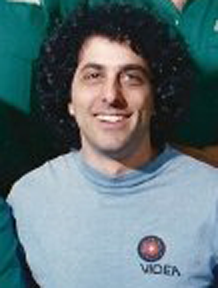
His career as a video game designer began in the 1970s at Atari, working on early coin-ops such as Super Bug and Asteroids. Along with Roger Hector and Ed Rotberg, he co-founded Videa (later renamed Sente Technologies), which helped usher in Nolan Bushnell's return to the video game business. Afterwards, he had a hand with some products for a few home-based gaming systems before returning to the arcade side at Midway Games.
Q: What’s your educational background?
Howard Delman: I have a BS in chemistry from Rensselear Polytechnic Institute, and an MS in Scientific Instrumentation from UC Santa Barbara.
Q: What inspired you to pursue a career in game design? Were there any games or products that inspired you?
Howard Delman: I got into video game design in a round-about sort of way. As a kid, I loved board games, like Monopoly, Stratego, Life, chess, and dozens more whose names I can't even remember. I also loved card games, like poker, gin rummy, spades, and hearts. In college, I discovered pinball machines, and couldn't get enough of those. I obtained my BS degree in Chemistry, but even before graduating I knew that I didn't want to spend my life breathing toxic fumes. I heard about a program at UC Santa Barbara that offered a Masters degree in Scientific Instrumentation, and after learning more about it, felt that it was a better path for me. The program was multi-disciplinary, and focused on training students in the design of one-of-a-kind instruments for scientific research. Although the PC had yet to be invented, machines like the Digital Equipment PDP-8 were being brought into labs, and were revolutionizing the ways in which scientists were doing their research. And just a few years earlier, Intel introduced the 4004, the "computer on a chip." A lot of my time was spent learning how do design with these new technologies, and how to write software.
Q: How did the opportunity at Atari come about? Were they the first game company you worked for? What was your official title there?
Howard Delman: As graduation neared, I was faced with the dilemma of deciding what sort of work I wanted to do. I still didn't really want to spend my years in a research lab somewhere... I wanted to create things. So one spring evening, as the semester was winding down, I was out having drinks with classmates at the Cold Spring Tavern, and we were playing one of the new video games. It was Tank. Suddenly, I had an epiphany. I could use my knowledge to design video games. I literally turned the machine around to read the name and address of the manufacturer. I wrote a letter asking for a job, and within a short time, I was hired as an "engineer" and shared an office with Dennis Koble and Dan Van Elderen in Atari's development facility. When I left five-and-a-half years later, I was the Supervisor of the electrical engineers.
Q: Can you talk a bit about the games you helped develop while at Atari?
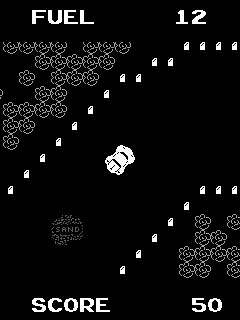 Howard Delman: In those days, the lines between hardware engineers and programmers were fuzzy.
My first project was the game Super Bug, and I was both the hardware engineer and the programmer. Since it was my first game, I certainly needed a lot of support, and drew a lot of inspiration from the more experienced engineers. The game was initially called "City Driver". I was shown some drawings, that I think were done by my first Manager, Lyle Rains.
I can't say that I really "picked" that as my first game, but I was excited to
be given the chance to develop it. It presented a top-down view of a city
street. The player had a fixed amount of time to drive his bright, yellow
"bug" as far as he could. Obviously, the idea was to drive as fast as
possible. This was made difficult by sudden turns in the road, surprise
oil slicks, sand traps, and parked cars. The player could choose from one
of two tracks. His controls consisted of a gas pedal, a steering wheel,
and a four-speed shifter. The logic was completely TTL. The microprocessor
was the Motorola 6800, an early eight bit device. I wrote the software in
Assembly language.
Howard Delman: In those days, the lines between hardware engineers and programmers were fuzzy.
My first project was the game Super Bug, and I was both the hardware engineer and the programmer. Since it was my first game, I certainly needed a lot of support, and drew a lot of inspiration from the more experienced engineers. The game was initially called "City Driver". I was shown some drawings, that I think were done by my first Manager, Lyle Rains.
I can't say that I really "picked" that as my first game, but I was excited to
be given the chance to develop it. It presented a top-down view of a city
street. The player had a fixed amount of time to drive his bright, yellow
"bug" as far as he could. Obviously, the idea was to drive as fast as
possible. This was made difficult by sudden turns in the road, surprise
oil slicks, sand traps, and parked cars. The player could choose from one
of two tracks. His controls consisted of a gas pedal, a steering wheel,
and a four-speed shifter. The logic was completely TTL. The microprocessor
was the Motorola 6800, an early eight bit device. I wrote the software in
Assembly language.
I'd have to say that every bit of it was challenging, considering that I had never designed a video game before. I had to learn how the software development systems worked, how to get prototype hardware and printed circuit boards made. This was far more complex than anything I had designed in school. And it had to be manufactured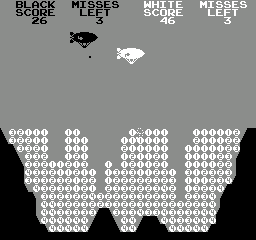 without my personal assistance. I couldn't be in the factory, tweaking each game. So I had to learn about proper documentation, production testing, purchasing, and all sorts of other things that I had never considered when I was only building one of something. At the end of the development, which took about nine months, I was quite proud of what I had created, and certainly learned an enormous amount of stuff, both hardware and software.
without my personal assistance. I couldn't be in the factory, tweaking each game. So I had to learn about proper documentation, production testing, purchasing, and all sorts of other things that I had never considered when I was only building one of something. At the end of the development, which took about nine months, I was quite proud of what I had created, and certainly learned an enormous amount of stuff, both hardware and software.
Canyon Bomber was a game suggested by Nolan Bushnell. I was excited about the idea of working directly with him, and eagerly accepted the game concept. The development went smoothly, especially since the hardware was based on the hardware used in the game Sprint II. Although I did do some modifications, most of my efforts were on the software side. In those days, programs were stored in ROM (read-only memory) chips that held only 2K bytes. That's not a typo... only 2,048 bytes per chip, and the chips were relatively expensive. When the game was done, my code was around 2500 bytes. My boss, Steve Calfee, bet me that I couldn't shrink it to fit into a single chip, thus saving significant cost. I accepted the challenge, and won the bet. Canyon Bomber shipped with a single 2K ROM, and all 2,048 bytes were used.
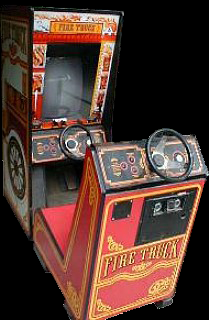
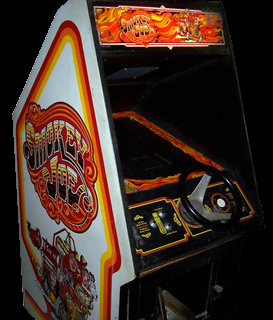
(LEFT) Fire Truck; (RIGHT) Smokey Joe.
Fire Truck was completely built on a foundation of Super Bug. John Ray enhanced the hardware while I enhanced the software. The game grew out of a brainstorming session in which someone asked, "Why are there no two-player cooperative driving games?" The reason, I guess, was that no one had been able to figure out what that would be. But someone realized that fire trucks require two cooperating drivers, and the game was born. I can't remember how it came to be that Fire Truck was an extension of Super Bug, but since it was, I was the logical person to implement it. There was one challenging aspect to Fire Truck's development, and that was coming up with a way for one person to play it alone. I needed to create a computer intelligence, which Super Bug didn't need, and it had to be able to drive either the front or the back. I did do it, but it took a lot of tweaking to get something that would feel okay without feeling over controlling. Internally, Smokey Joe was identical to Fire Truck.
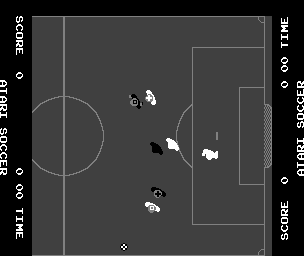
I also worked on the game Atari Soccer, which was a big hit outside of the United States, as well as several other games that never even made it out of the labs.
Q: According to KLOV entry for Super Bug, this was the first arcade game to feature a scrolling playfield. How hard was it to implement this feature?
Howard Delman: I'll have to take your word that it was the first game with a scrolling playfield. Admittedly, I can't think of a previous example, but it was 35 years ago!
Implementing it didn't seem all that difficult. As I mentioned earlier, I didn't really design the Super Bug hardware from scratch. Since I had never designed video game hardware before, Lyle Rains blocked out the circuits, and I filled in all of the details.
I do remember having trouble getting the software to write the data into the proper places in the playfield memory. As the playfield scrolled, so did the memory addresses. But of course, I did finally figure it out. :-)
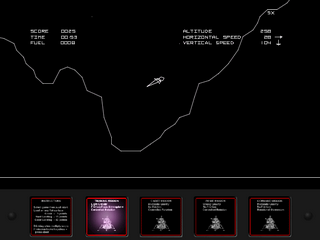 Q: You also helped ‘finalize’ (if that’s the correct word) the “Quadrascan” vector
monitor hardware for Lunar Lander and Asteroids...
Q: You also helped ‘finalize’ (if that’s the correct word) the “Quadrascan” vector
monitor hardware for Lunar Lander and Asteroids...
Howard Delman: I had a lot of involvement with the vector generator system which was used in probably a dozen games. I was the project engineer (known today as "producer") for Lunar Lander, Atari's first vector graphic game. The original concepts for the vector graphic technology came out of Atari's research facility in Grass Valley. The engineers from there demonstrated a vector graphic system to us, and left the prototype with me. I refined the vector generator, cleaned up some problem areas, and added the necessary support hardware to make it usable in a video game machine. Rick Moncrief did the same with the vector monitor.
As the system was coming to fruition, it was obvious that a game needed to be implemented on it, rather than continuing with test patterns. I suggested Lunar Lander, and that became the real test bed for the technology. I continued working on the hardware, Rick Moncrief continued refining the monitor electronics, and Rich Moore wrote the software.
Q: Most Asteroids fans have heard the first Asteroids machines produced used Lunar Lander cabinets, but probably most haven't heard that a Lunar Lander pcb was used in developing the Asteroids pcb. Can you talk a bit about that development?
Howard Delman: The photo below appeared for the first time in Retro Gamer magazine, a couple of years ago. Before then, no one had seen this board in 30 years, other than family members who happened to be rummaging through my closet <G>:
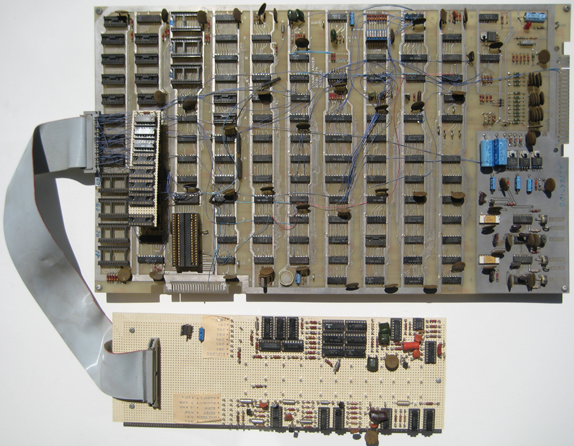
Lunar Lander board on which Asteroids was developed. Click image for full-size version. Photo courtesy of Howard Delman.
I do want to draw your attention to a few things. The large PCB is, of course, a Lunar Lander PCB. If you look in the middle of the board, toward the top, you can see the legend "Lunar Lander Atari (c)79." And if you look carefully, along the lower right edge, you can see the word "Asteroids" written in blue ink. The "piggy back" board near the left edge, is the additional memory that Asteroids required. All of the blue
wires are modifications necessary to turn Lunar Lander hardware into Asteroids hardware.
The smaller board below is the sound board that I designed. You'll notice that it is all hand-built. Some of the notes on the test points are interesting.
Naturally, once we were confident that the hardware was adequate for the game, I had a new PCB designed which incorporated all of the changes.
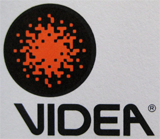 Q: After Atari, you co-founded Videa with Ed Rotberg and
Roger Hector. Was this in 1982?
Q: After Atari, you co-founded Videa with Ed Rotberg and
Roger Hector. Was this in 1982?
Howard Delman: We left Atari in October of 1981, and bounced around namelessly for a while. I believe that Videa was actually incorporated in early 1982.
Q: Concerning Videa's brief foray in developing games for the 2600, did you have any involved with those?
Howard Delman: I had no direct involvement with the 2600 games at Videa, other than my regular role as an executive of the company. Of course, Videa was a small company in a small space, so I was very aware of what was going on, and took part in discussions and reviews about the games (legally, I am still a 1/3 owner of the two games). We sold them first to 20th Century Fox, then to Parker Brothers, and finally to Atari. We made a lot of money off of two games didn't see the light of day for another 25 years! The two games we developed, Lasercade and Meltdown, are finally available. We agreed to put Meltdown into the public domain, after we learned that the ROM code had been leaked anyway. Lasercade was licensed to CGE Services.
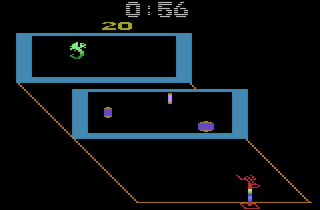
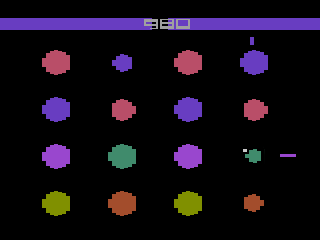
(LEFT) Lasercade; (RIGHT) Meltdown.
The history of Videa's 2 VCS games is murky, because it only began to be written years after the fact. I would take everyone's recollections and average them all together. I doubt any of us really remember the exact details. Having said all of that, here is my recollection - the games were not actually "sold", but were licensed. I believe 20th Century Fox paid us $50,000 as an advance on royalties for the license to manufacture and sell the two games. In accordance with the license agreement, when they went out of business, the license terminated. Parker stepped up, and signed the same deal with us, but they went out of business right after signing and paying, so again, the games were available. I believe our agreement with Atari was different. They were only interested in one of the games (Ed.: According to Lee Actor, it was Lasercade), and wanted to test it before committing, so they paid us an "option" fee, which was much less than we had gotten from Fox and Parker. I don't recall if they actually did any testing, but they informed us that they were not going to exercise their option. The games went back into my desk drawer at Videa, moved to my desk drawer at Sente, and finally ended up in the desk drawer of my home office.
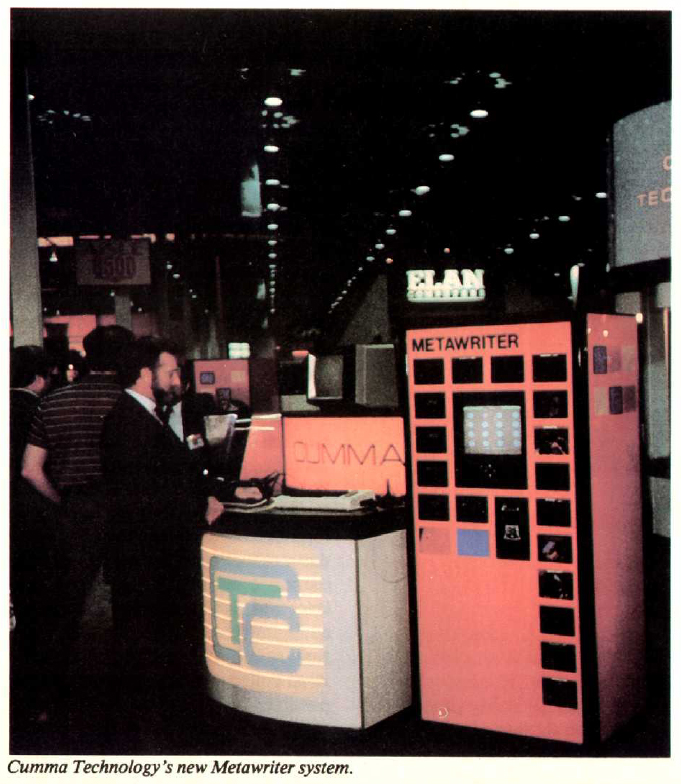
Q: There also seems to have been at least one more licensing agreement, with Cumma Technology. They offered Meltdown (under the name Atom Smasher) with their MetaWriter display at the January 1984 Winter CES. The above photo is from the April 1984 issue of Video Games magazine (pg. 35) and shows the MetaWriter displaying Atom Smasher on its monitor.
Howard Delman: Wow! I have zero recollection of doing any licensing deals with Cumma. In fact, it took me a while even to remember what Cumma was. Maybe Cumma didn't actually have a license. It was Nolan and Al's company (Ed.: According to company literature, Cumma was founded in 1983 by Al Alcorn and Thomas Cracraft, with help from Nolan Bushnell and Joe Keenan), and it was just a trade show demo, so maybe we just let them use it.
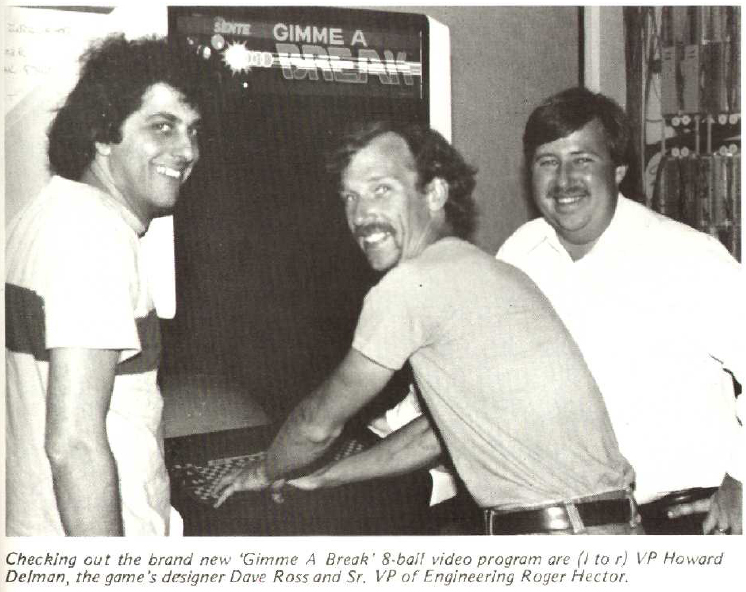
Article photo from the August 1985 issue of
RePlay (pg. 41).
Q: When did Bally purchase Sente? Going from working at some of Bushnell’s companies to a “stuffy” company like Bally must have been quite a contrast.
Howard Delman: Trying to remember dates from that long ago is challenging. As best as I can recall, Pizza Time Theater filed for bankruptcy very early in 1984, just as we had begun shipping Snake Pit. Bally's purchase of Sente was finalized in May of 1984.
The Bally acquisition definitely changed things. We were now being managed out of Chicago, by executives who ruled by fear and decree, and were not used to hearing dissent. They were very attuned to expenditures, which is not necessarily a bad thing. However, it was very difficult getting anything done since every dime had to be approved by someone on the other side of the country, who really didn't know us, or understand what we were trying to do.
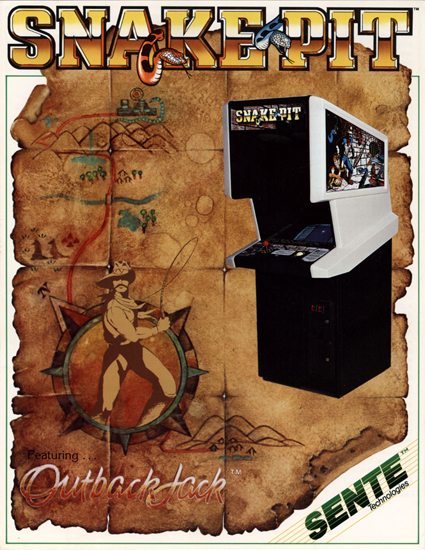
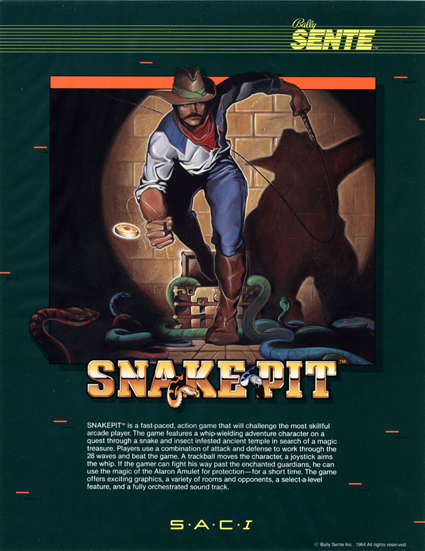
(LEFT) Original Snake Pit flyer by Sente Technologies; (RIGHT) Bally Sente version.
Q: Was Snake Pit the only true Sente game?
Howard Delman: Snake Pit was the only game released under the name Sente Technologies. Sente Technologies was initially developing 8 games - Chicken Shift, Off The Wall, Trivial Pursuit, Stocker, Snacks 'n Jaxson, Goalie Ghost, Hat Trick, and Snake Pit. Snake Pit was the first to be released, which happened to be about a month before Pizza Time Theater filed for bankruptcy. We languished for several months, until PTT concluded the deal with Bally to purchase us. By the time the deal was done, so were all of the games, and we launched Bally Sente with all eight.
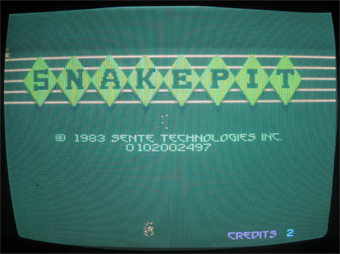
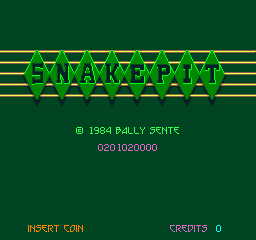
(LEFT) Sente Technologies title screen (photo courtesy of Howard Delman); (RIGHT) Bally Sente title screen.
Q: What's the string of numbers underneath the copyright for? Was this the game's serial number?
Howard Delman: We intended to serialize the cartridges, and there was a non-volatile memory chip on the cart for that purpose. But once we started production, we decided that serializing was more trouble than it was worth, especially since no one had a good idea of what to do with the information anyway. At some point, the memory chip went away. If the software was trying to read the non-existent chip, it would get random numbers.
Q: Can you talk a bit about the game's development?
Howard Delman: Lee Actor was the main programmer for Snake Pit, and Ed Rotberg helped him out. This was Lee's his first video game, as well as the first game that Sente began developing for the SAC-I (which I coined. It stands for "Sente Arcade Computer"). I had little to do with software development specific to Snake Pit, other than to explain to Lee and Ed how the hardware worked. Most of my involvement was using the evolving Snake Pit software for validating my hardware. I shouldn't be listed as a programmer for Snake Pit.
Q: How many "dedicated" Sente Snake Pit machines were made?
Howard Delman: In the back of my mind is the number 125 - the number of Snake Pits shipped by Sente Technologies.
When Sente Technologies was getting ready to introduce SAC-I and Snake Pit, we had a large show in Milpitas for our distributors. We made a commemorative poster for the event, and I've been holding on to two of them. This is a photo of one of them. I had to unseal the shrink wrap (after 27 years!) in order to photograph it for you. If you look closely along the right edge, near the bottom, you can see it says "(c)1984 Sente Technologies, Inc." I find that
interesting, because my recollection is that the show was in December '83, and PTT shut down in early Jan '84. But of course, I could be wrong.
Q: I know of two other people who claim to have Snake Pit posters, but I don't know if they're the same as yours. One claims to have got his from a coin-op show in Chicago...
Howard Delman: I doubt that the posters were ever given away at game shows. There were only two video game shows back then... the AMOA in late October, and ACME, in March. I remember the October '83 AMOA well, because we had nothing ready to show. So instead, we put an empty box in the booth, and handed out buttons with the Sente logo that read "no comment." By the time the ACME show came in March of '84, PTT was bankrupt, and Sente Technologies was on hold. I can't remember if we even went to that ACME show. Certainly, we couldn't have been promoting anything when we didn't know if we would ever come back to life. So I'll stand by my original comment, which is that the posters were printed for the distributor show in late December '83, when we introduced the SAC-I and Snake Pit (it is curious, though, that the copyright reads '84!).
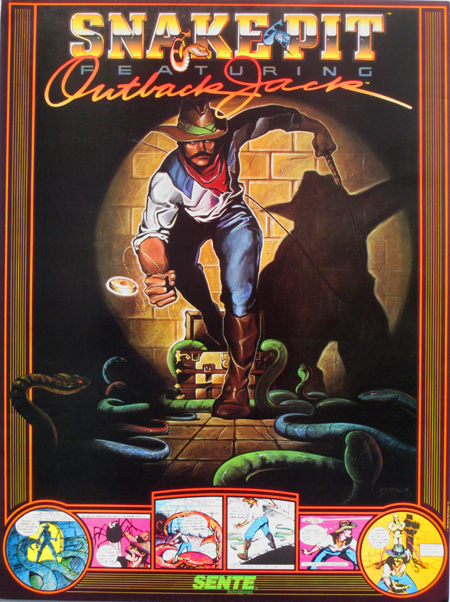
Rare Snake Pit poster! Click image for full-size version. Photo courtesy of Howard Delman.
Q: How many games used that huge, white cabinet, or was Snake Pit the only one?
Howard Delman: I can't recall when we made the cabinet change. I remember that Bally was quite upset with the cost of that cabinet. Keep in mind that the Sente concept was based around the idea that the cabinet wouldn't have to be moved once it was in a location. From that idea was born a cabinet with a steel frame, instead of wood, and plastic sides that could be quickly replaced if damaged or worn. The cabinet was a separate product from the game kits, although each cabinet was sold with one "free" kit of the customer's choosing. Bally never bought into the convertible game concept, and so features like a robust cabinet were just seen as wasteful. The original Sente white "refrigerator" cabinet, and the subsequent Bally Sente "normal" black cabinet were compatible, as far as the hardware. Games kits would fit into either one. Our original intention was to include unique side art in each game kit, but it became clear very quickly that applying a decal to the side of a cabinet was difficult, and not likely to be done. I believe Snake Pit was the only game for which sideart was made. Subsequent cabinets went out with generic side art.
When Pizza Time filed for bankruptcy and halted production, we had a PR problem. We had sold the notion of this relatively expensive "convertible game system", but suddenly it was questionable whether subsequent games would ever be released. Not surprisingly, customers were upset, so Sente agreed to accept Snake Pits back for return. My sense is that most of the machines were returned to us. It would make sense that when we resumed production as Bally Sente, the software would have been changed to show "Bally Sente", rather than "Sente Technologies". Whether or not the side art or control panels were changed as well, I don't remember. I would guess that the original, pure "Sente Technologies" machines that still exist were probably machines that were not returned after the bankruptcy.
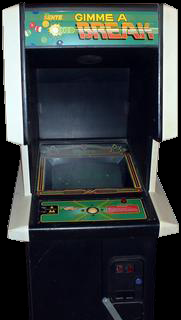
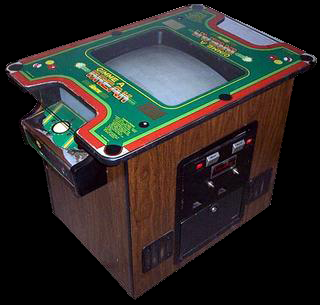
Upright and rare table version for Gimme A Break.
Q: How was it Atari used the same name as one of your games (Off The Wall) 7 years later?
Howard Delman: A trademark is only useful if you enforce it. I doubt anyone at Williams, who ultimately ended up owning the Sente IP, realized or cared.
Q: I’d like to talk about your time working for various game companies, what the development process was like at each, the hours in those departments, etc. Were the titles you worked on assigned, or chosen by yourself?
Howard Delman: I can't recall ever having a game project forced upon me. To do so would have been dumb. Certainly, games were "offered" to me, but the final decision was always mine. After all, game development, even on the hardware side, is a creative process. If my heart wasn't into a project, it is hard to imagine that a quality product would have resulted.
One of the wonderful things about the video games business, at least when I was in it, was the flexible hours. I came in when I wanted (within reason), and left when I wanted. I could do it because management knew that in the end, I would put in more than my expected time and meet my deadlines.
Q: Do you remember what early or tentative titles your other games had (if any)? I know Asteroids was known by several (such as Cosmos and Planet Grab).
Howard Delman: The only thing I can remember is that Super Bug was originally called City Driver.
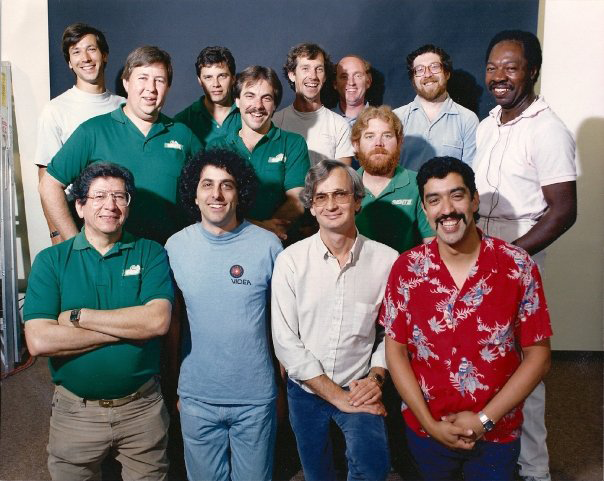
Sente staff circa summer/fall 1984. Back row: Pete Mokris, Rich Adam, Dave Ross, Denis Koble, Lee Actor, Jesse Osborne.
Middle row: Roger Hector, Owen Rubin, Paul Brandt.
Front row: Bob Flemate, Howard Delman, Bob Smith, Willy Aguilar.
Q: Were there any games or projects (such as Gridlee and Shrike Avenger) that you (or a co-worker) worked on that ultimately never got released or even finished? Perhaps they featured a unique feature that proved to be too expensive or unreliable?
Howard Delman: There were many games that were never released. I'd guess that less than half of the games that were started at Atari ever made it to the field testing phase. Probably half of those weren't built because they didn't test well.
I remember working on a game at Atari called "Dozer." I was living in an old farm house at the time, and there was a huge empty field next to me where big eighteen-wheelers were parked. On the weekends, the truck owners would come out with their wives and kids, wash their trucks, have a picnic or BBQ, and make a day of it. One weekend, they showed up with a bulldozer, and spent the day taking turns digging holes and making mountains. As the sun went down, they restored the field to flat, hitched up their 'dozer, and left. It seemed clear to me at that moment that a bulldozer game should be a hit. I designed some hardware suitable for rendering hills and valleys with relative ease, and set about designing and programming the game. Unfortunately, no matter how much I tweaked and fiddled with the game play, it was never really all that much fun.
I also worked on a game at Atari called "Space Shoot." It was loosely modeled after a scene in the movie "The Last Starfighter", in which the hero is being trained to use a futuristic laser type weapon to shoot brightly colored orbs out in space. I designed some hardware for rendering multi-colored circles, and created what was, in essence, a skeet shooting game. One of Atari's mechanical engineers designed a cool-looking "space gun" for me, and I had a reasonably fun game coming along. But in the middle of the project I left Atari to start Videa, and the project died with my departure.
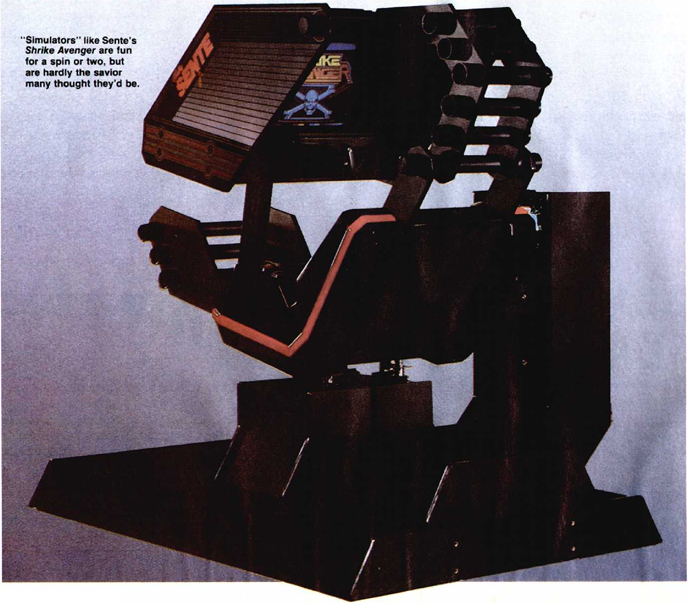
Photo from the June 1985 issue of Computer Entertainment (pg. 64).
Probably the most extensive (and expensive!) development effort that never saw production was Shrike Avenger, at Bally Sente. This was a video game implemented in a motion-controlled seat, which we referred to as SAC-II. Within the SAC-II, there was a full SAC-I board set for implementing the video game, a digital controller board for managing the motion of the seat, and a high current analog controller board for directing the current through the four
motors that moved the seat. The video game was a basic "fly through space and shoot everything" game, with lots of very nice graphics and full surround sound. The big feature, of course, was the motion seat. Pete Mokris developed the digital motor controller, and I developed the analog controller. I have to admit that I had had little training in switching 50 amps of current at 110 volts into motors at the exact proper times, but I did manage to learn as I went. Not surprisingly, people in the
building insisted that I have my own electrical feed because they were tired of losing work every time I blew out the main circuit breakers in the building!
It was challenging to get the motion logic right. At one point, the seat was so violent that people were being tossed out of it! Yet, toning it down lead to a mushy feel. We did, eventually, get a response that felt good, yet wasn't so dramatic that people risked getting hurt. (An electrical interlock ensured that the motion stopped if the seat belt was opened.)
We built ten prototypes, and put them out on test. If I recall correctly, three went to the Great America theme park in Santa Clara, and a couple went to the Santa Cruz Beach Boardwalk. I'm not sure where the others went. In general, the machines earned huge amounts of money when they operated. Unfortunately, the machines died regularly. Despite our best efforts, both mechanically and electrically, they just kept shaking themselves to pieces. Since we had only built the ten prototypes, we didn't
have a lot of spare parts, and so we had to start cannibalizing machines to keep others going. In the end, Bally decided that Shrike Avenger represented more of a liability than a good idea, and so the project was killed. The operator at the Santa Cruz Beach Boardwalk asked if he could keep the machines that he had, so we agreed to sell him all of the remaining prototypes and pieces. I can remember seeing one running for several years afterward, but eventually, it went away. I have no idea if,
somewhere in the vast warehouse at the boardwalk, there is a working Shrike Avenger machine.
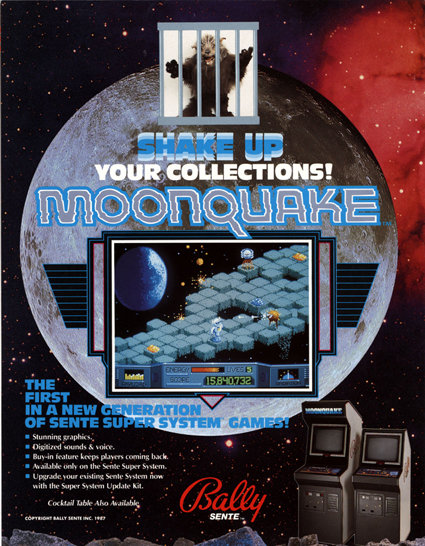
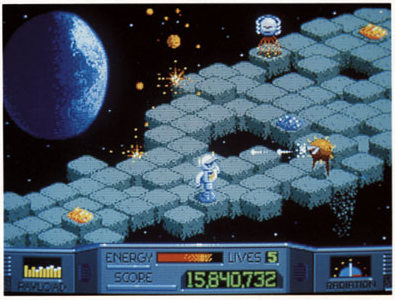
(LEFT) Flyer for Moonquake; (RIGHT) Screenshot from flyer
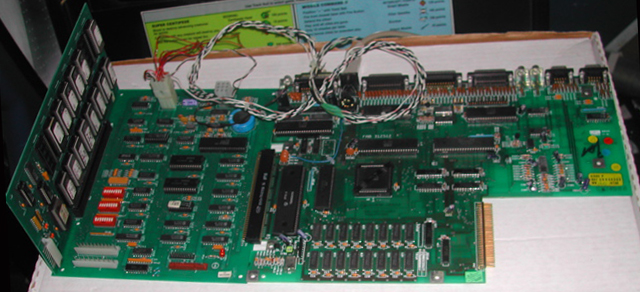
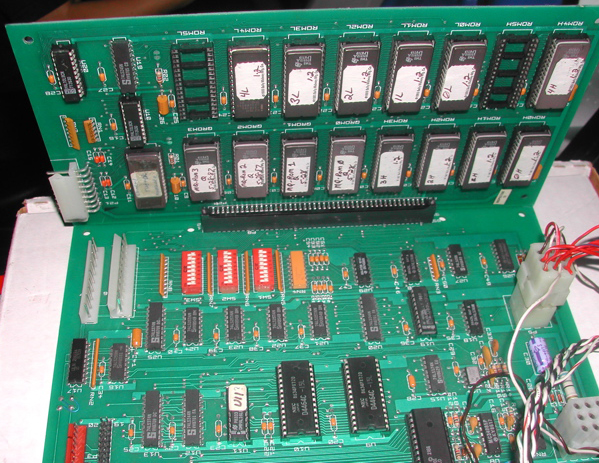
Moonquake prototype hardware (photos courtesy of Scott Evans).
Howard Delman: Another project that was never released was Moonquake. It was built on a platform that was going to be called the SAC-III system, but was, in fact, an Amiga 500 motherboard. I designed a cartridge type interface for it, so games could run out of ROM, instead of off a hard drive. It was shown at a trade show, but was never released to production.
Q: Would you happen to still have a copy of that? As with the original version of Snake Pit, Moonquake has never been archived either.
Howard Delman: I didn't find anything related to Moonquake, but I did find a Snake Pit cartridge and what I believe to be a Shrike Avenger cartridge! This board is about 18 inches wide, about 12 inches deep, has two SAC-I connectors, and about two dozen ROMs. Shrike Avenger had a SAC-I board for game play, and if I am remembering correctly, and digital motor control board. But
maybe I'm wrong, and that it used a second SAC-I board for motor control. I just don't remember. In any case, it is not clear that there is a straightforward way to connect this cartridge to a SAC-I, without first disassembling the entire electronics tray. And then, it is not clear that it would work without the motor electronics. We had a lot of safety and "fail safe" hardware in there, to prevent the seat from going nuts on its own.
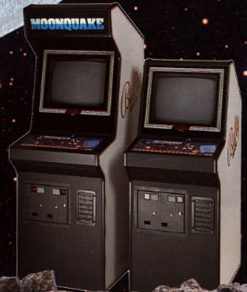

(LEFT) SAC-3 cabinets and early (prototype?) Moonquake marquee from flyer; (RIGHT) Actual Moonquake marquee.
Q: The Moonquake flyer describes a cabinet called the Sente Super System, in full-size upright, cabaret, or table versions. I don't think I've ever seen any of those before.
Howard Delman: I wouldn't swear to it... but I think the "Super System" may have been the Amiga based hardware that I kludged together to run Moonquake. We did show Moonquake at a trade show, so must have been a bunch made. I just can't remember.
Q: There was SAC-I (original upright cabinet), SAC-II (the Shrike Avenger motion cabinet), and SAC-III (Amiga hardware). In Video Games magazine, an article in the March 1984 issue (pg. 14)
and an interview with Nolan Bushnell in the May 1984 issue (pg. 68) both mention a "SAC-4" but don't describe it. Was there a SAC-4?
Howard Delman: Probably only in Nolan's imagination. :-)
Q: Occasionally, programmers would put little “Easter eggs” in some of their games that would reveal their name, or a message. Are there Easter eggs in any of your titles? Do you recall any fellow co-workers that did?
Howard Delman: I am not aware of any Easter eggs in any game that I worked on. I never put any into my any of my code.
Q: Were you with Sente until they shut down?
Howard Delman: I'm not sure exactly when Sente went away. I left Sente in May of 1987, three years to the day after the acquisition, on the day my three year contract expired. I joined Axlon a few months later, starting in December 1987. It was actually the last time that I was employed!
When I joined, Axlon was already on the way down, having laid off most of its staff. Nolan wanted me to design a new arcade game platform, and I got to work on it, but when it was time to spend money for tools and services, there were none available. I languished for a few months, dabbling in whatever I could, but the writing was on the wall. Eventually, Bob Lundquist, Axlon's president, and I were the only two employees left. We decided to lay each other off, and
go out for cocktails.
Q: You stayed in the industry for many years afterwards, working on hardware projects for systems such as Sega’s Genesis, Atari’s Lynx, and Trip Hawkin’s 3DO. What are your opinions about those systems and products? How was it a superior system such as the Lynx failed to make much headway in the handheld market when their main competition was Nintendo’s GameBoy?
Howard Delman: My involvement with the Sega Genesis was focused on the development of the Edge 16, which enabled players to play against each other over a phone line. This was in the early 90's, before the Internet became a household commodity, and few people had modems at that time. The Edge 16 plugged directly into a regular household phone line, and required the player to place a phone call to the person he wanted to play with. It had a built in speaker phone, so the players could talk to each other while they played. It was all "point to point" over an analog phone line. As far as my opinion of the Genesis itself... it was a nice machine, and fairly straightforward to enhance.
The Lynx was a wonderful machine, and I always felt it should have done much better than it did. I became involved with it when it still only existed on paper. The hardware was being designed by Dave Needle, formerly of Amiga, and he retained me to help create prototypes that would allow the programmers to begin testing their code. The Lynx hardware was really only a couple of custom chips, and those chips were many months from existing. Dave asked me to take the schematics of the chips, and convert them into something that could be built using off-the-shelf components. I did so, and if I recall correctly, the Lynx prototype hardware could scarcely fit on a normal sized desk. But it did work, and not only could the programmers begin to test their code, but Dave could see that his hardware design was good.
Having prototype hardware was only one step in the development process, though. Programmers really needed development systems that would allow them to debug their code, analyze its performance, trap bugs, etc. So I designed a complete development environment, based on the two Lynx chips. This board, which came to be known as "The Howard Board", was used by all of the developers of Lynx games.
My involvement with 3DO was very limited. Dave Needle was also the hardware designer of that system, and I did some similar work, building off-the-shelf prototypes of the custom chips. I wasn't involved long enough to see any software development.
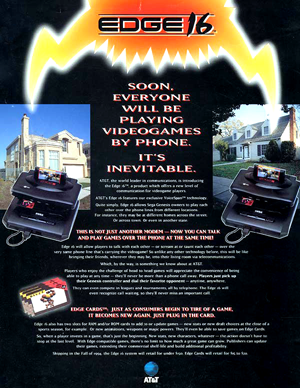
Q: The Edge 16 was advertised in magazines at some point, but ultimately became vaporware. What do you recall about that particular product?
Howard Delman: I initially began working on the Edge 16 for a company called Interactive Productions, which had been founded by Rob Fulop, of Imagic fame. At some point (there may have been a merger or investment, I can't remember) the name changed to
PF. Magic. The original design included a commercially available generic modem chip manufactured by Phylon. At some point, someone at PFM met someone at AT&T, and a deal was struck. AT&T would provide us with a new modem, still under development, that allowed voice and data to travel on the same phone line. There was also money for development, and a licensing deal the details of which I wasn't privy to. The final product would have been manufactured and sold by
AT&T under their name.
The Edge 16 was shown at a CES show (1994?), in both the PFM and AT&T booths. At a press event, the president of each company was in their respective booths, playing against each other. There was one game, Ballz, that supported the Edge 16.
I was at the AT&T factory in Guadalajara, Mexico, when production was about to start (September 1994?). All of the parts were there, everyone was trained, and all was set to go. Then word came down from somewhere to delay the "turn on" of the line. We sat around for a few days, and then word came that the president of AT&T decided that he didn't want to be in the games business. Under the terms of the agreement, the Edge 16 reverted back to PFM. Unfortunately, there
was no way at all that PFM could have found another manufacturer in time to get product out that year. We also knew that by the following Christmas shopping season, the Genesis would be history. So the Edge 16 became a footnote.
Q: Rob had also mentioned doing work for it to support both the Genesis and the SNES. Was an Edge16 device planned for the SNES as well?
Howard Delman: I have no recollection of discussing an Edge 16 for any other platforms other than the Genesis.
Q: What were some of your experiences working in the game industry? Do you have any stories or anecdotes from those days that you relate for us?
Howard Delman: Working in the video game business in the "early days" was an amazing experience, and I guess it was similar to stories being told today about companies like Google and Facebook. We were mostly in our 20's, full of excitement and unlimited vision. We were pushing technology boundaries without even knowing exactly where we were going. Most of Atari's executives had engineering backgrounds, and they appreciated and understood the uniqueness of creative design. We were given a lot of freedom to try new things, to experiment, and to fail without consequence.
I remember seeing the first prototype of the Atari 2600, and thinking how remarkable it was that we were bringing video games into the home.
Q: Can you describe your career, between then and now, and where you’re currently involved with?
Howard Delman: After a dozen years working as an employee and a corporate executive, I decided become an independent contractor. My years spent as Sente's VP of engineering were very frustrating. One reason is that I am a tinkerer at heart. I wanted to be in the lab, rather that in meetings. Another reason is that I became aware of the reality that an employee always has to have something to do. I spent a lot of time on tasks that didn't interest me in the least. As an independent contractor, I could design a product, see it through to the marketplace, and then move on.
Over the years, I've designed everything from joysticks (Creative Labs) to telephone test sets (Metrotel). Along the way, I've consulted for Apple, the U.S. Navy, and over a half-dozen video game companies.
Q: Do you still own any of your games for these systems, either as a keepsake, or to show friends or family?
Howard Delman: I have a Canyon Bomber game in a home-brew cabinet. I have the Lunar Lander prototype - still working - that went on field test. I have the prototype of the Asteroids "cabaret" cabinet, with a playable Asteroids game in it. I have a production version of the original Sente "refrigerator" cabinet, as well as every game cartridge that we produced. The last time I looked, it was running Hat Trick. I have the development cabinet that we used in Milpitas while developing the "Diego" and "MagicBus" boards used in Midway's Hydro Thunder, Offroad Thunder, and others. It is currently running Hydro Thunder. Better than all of that, I think, is that I have the prototype Asteroids board. It was a Lunar Lander PCB, that I modified with additional memory, and all of the unique Asteroids sounds.
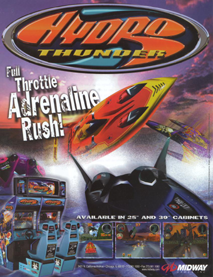
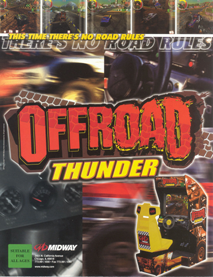
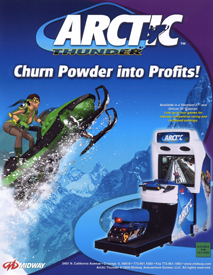
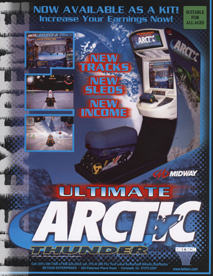
Flyers for Hydro Thunder, Offroad Thunder, Arctic Thunder, and Ultimate Arctic Thunder.
Q: Which of your titles are your favorite, and what types of games in general?
Howard Delman: This might seem heretical, but I've always been a bigger fan of pinball machines than of video games. Atari had some great machines, during their brief foray into pinball. In particular, I have fond memories of Middle Earth and Time 2000. Some other great classic pinball machines were Fireball, Flash, and 8 Ball. Just last week, I played Bally's great electro-mechanical, Capt. Fantastic and The Brown Dirt Cowboy, from 1975.
Q: Have you stayed in touch with any of your former co-workers?
Howard Delman: Many of them. I am in regular contact with Steve Bristow and Noah Anglin. Just last week, I had coffee with Ed Logg at Mike Albaugh's house. I periodically see Steve Calfee, Roger Hector, Ed Rotberg, Dennis Koble, Dan Van Elderen, Owen Rubin, Lyle Rains, Dave Stubben, and many others.
Q: What are your thoughts on how the industry has evolved?
Howard Delman: When I was designing arcade games in the 70's, a development team had a handful of people. In fact, without minimizing the contributions of my fellow engineers, a couple of my games were, officially, teams of only one... me. I created video display hardware and audio generation circuits, and then wrote the software. If I needed some graphics, which were mostly geometric shapes, I either sketched something myself, or asked a coworker for some help. Asteroids was basically designed by three people - Ed Logg, Lyle Rains, and me. Lyle worked with Ed on game play and graphics. I created the sounds from discrete hardware circuits, and worked on improving the vector generator. There were other people contributing, such as technicians, assemblers, computer operators, mechanical engineers, cabinet designers, etc, but the core of what is thought of as Asteroids really came from a very small group of people. As we moved into the 80's with Videa and Sente, design teams began to include a dedicated graphic artist and a dedicated sound designer. Hardware design and software design separated, as each became too complex and time consuming to be done by one person in a reasonable amount of time. But even in the late 80's, a design team could fit into one person's office, where they might continue refining aspects of the game and brainstorming on its evolution. Today, game design teams consist of hundreds of people. Some of those people are only on the team to manage others and to facilitate communication between members. The game has to be fully defined before the bulk of the team gets to work, because making any creative decisions along the way could affect scores of other team members. Today, it is much more like making movies; back then it was more like making toys.
Q: Now those toys out-earn the movie and music industry, combined. But as big as it's become, there's still a small segment of people still interested in those golden-era games. And the homebrew scene for classic systems such as the Atari VCS/2600 has really evolved into its own "industry".
Howard Delman: I just browsed around and I'm amazed at how much ongoing interest there is in this stuff, with people still writing new games for the old systems. Who would have guessed? When I first began working for Atari in '76, our labs were in a building in Campbell, a few miles from Atari's main offices in Los Gatos. It was a way to keep our work relatively "secret" from everyone else in the company. Within our offices, there was an even more "secret" lab, which I wasn't allowed to enter, and no one was supposed to discuss. Of course, it didn't take long for me to learn that it was a group developing home game machines... first Pong, and eventually, the 2600. Inevitably, I got inside, and was able to watch the engineers (I think one was Jay Miner) checking the tapeout of the original home Pong chip. I also got to watch the engineers testing the first 2600 games on the prototype breadboard... a bunch of hand-wired boards the size of a desktop! And here we are, 35 years later, still discussing it!
Btw, the headshot you're using for the interview is funny, being so old, but I'm okay with it. Maybe it will help me compete with the 20-somethings for new gigs.
Q: As if some 20-year-old fresh graduate could compete with you :)
Howard Delman: It is sad to say, but experience is not longer valued - youth is. Companies would rather hire an unmarried, 24-year-old who will work a 16-hour day, rather than a 50-something who could do better work in only 8 hours. So many of my peers (many interviewed on your site) are unemployed, retired by default, working part-time, working for insulting rates, or working outside of the tech business. It is so depressing to go to a party, and to hear how few of them are able to get any work commensurate with their skills and experience.
Q: You touched on something that I’ve always tried to cover in my interviews, when I ask people what their thoughts are about the game industry as it exists today. I've heard the same stories from others of that generation of designers, whether it's in interviews or at shows. There's definitely age discrimination in the industry today (as in others…), which is truly unfortunate. As you said, the choice is either to start up your own company, change careers, or retire. Yes, companies know they can squeeze more hours out of younger employees (and "crunch time" has devolved into another ‘dark side’ of the industry), but back then, people put in extra hours because they loved what they were doing (and a few mentioned they would have done it for free otherwise). Money only became an issue when people realized how much companies made from their work, and how little they were compensated for it. Today’s programmers put in 80-hour weeks because it’s somehow become ‘acceptable’ and ‘part of the job’. With games requiring huge budgets for development, there’s that much more stress on employees to produce, and with so many people involved in making any one game, I believe a person’s value” to a company has diminished to the point that what was once an insulting side comment (such as former Atari CEO Ray Kassar's comment that employees were "a dime a dozen") has became reality, and if someone in your situation can’t get into a large company with a position of some importance, it’s probably not a company worth working for. It’s always my hope that one of my interviews will help someone in a similar situation, whether it’s with a job, or help with networking with others, etc. Yourself and others blazed the trails into that frontier, and 30 years later everyone is still driving the same roads, just with newer wagons.
Howard Delman:
You speak the truth, but it is not limited to the video games business. I
hear of it in almost every industry. It is a national problem that will
have long-range social consequences, especially when combined with the
discontinuance of company pensions, job security, etc. I don't have enough
money saved to retire comfortably, yet I've had very little income for the past
three years. What will the attitudes of younger workers be if they realize
that they won't be able to sustain their incomes into their 60's?
Visit Howard's website for more information: http://www.rawbw.com/~delman/
Check out the website for the artist for the Snake Pit poster, Martin French, at: http://www.martinfrench.com/
His email address is studioATmartinfrench.com
| GAME | SYSTEM | COMPANY | STATUS |
|
Super Bug |
arcade | Kee Games (Atari) | released |
| Canyon Bomber | arcade | Atari | released |
|
Fire Truck |
arcade | Atari | released |
|
Smokey Joe |
arcade | Atari | released |
|
Atari Soccer |
arcade | Atari | released |
|
Lunar Lander |
arcade | Atari | released |
|
Asteroids |
arcade | Atari | released |
| Dozer | arcade | Atari | unreleased |
| Space Shoot | arcade | Atari | unreleased |
| Gridlee | arcade | Gottlieb (Videa) | unreleased (only 1 made) |
| Snake Pit | arcade | Sente Technologies | limited release |
| Snake Pit | arcade | Bally Sente | released |
| Chicken Shift | arcade | Bally Sente | released |
| Off the Wall | arcade | Bally Sente | released |
| Trivial Pursuit | arcade | Bally Sente | released |
| Trivial Pursuit All Star Sports Edition | arcade | Bally Sente | released |
| Stocker | arcade | Bally Sente | released |
| Snakes 'n Jaxson | arcade | Bally Sente | released |
| Shrike Avenger | arcade | Bally Sente | limited release |
| Goalie Ghost | arcade | Bally Sente | released |
| Hat Trick | arcade | Bally Sente | released |
| Team Hat Trick | arcade | Bally Sente | released |
| Gimme A Break | arcade | Bally Sente | released |
| Toggle | arcade | Bally Sente | released |
| Street Football | arcade | Bally Sente | released |
| Mini Golf | arcade | Bally Sente | released |
| Mini Golf Deluxe | arcade | Bally Sente | released |
| Stompin' | arcade | Bally Sente | released |
| Spiker | arcade | Bally Sente | released |
| Name That Tune | arcade | Bally Sente | released |
| Night Stocker | arcade | Bally Sente | released |
| Moonquake | arcade | Bally Sente | unreleased |
| Edge 16 (hardware interface) | Genesis | Interactive Productions (became PF. Magic), for AT&T | unreleased |
| Lynx prototype hardware | Lynx | Atari | unreleased |
| Lynx "Howard" development board | Lynx | Atari | limited release |
| 3DO prototype hardware | 3DO | The 3DO Company | unreleased |
| "Diego" and "MagicBus" boards | arcade | Midway Games | released |